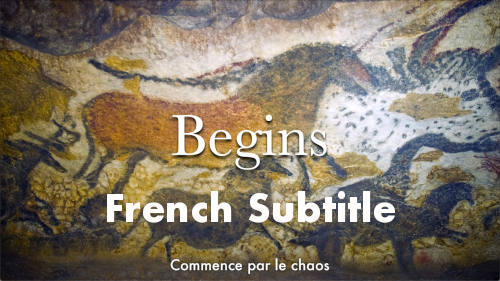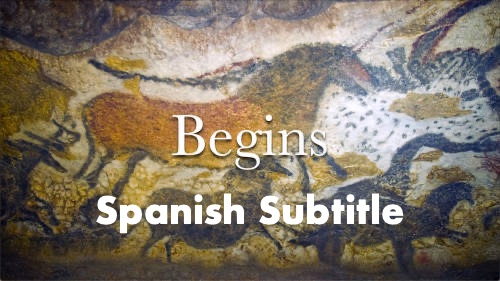This site's video is free to share.
Feel free to download and show them without permission.
You can donate any amount to the artist, if you approve of the video as art.
Even if you disapprove, you can keep it. But it has no artistic value, as you have determined.
Download:
Video Begins with Chaos - Lascaux, 1280x720, 102.6 MB
Video Begins with Chaos - Lascaux, 1920x1080, 267.2 MB
Video Begins with Chaos - Lascaux, French Subtitle , 1920x1080, 284.1 MB
Video Begins with Chaos - Lascaux, Spanish Subtitle , 1920x1080, 284.2 MB
High-resolution Image 01, Image 02, Image 03, Image 04, Image 05, Image 06
 "Begins with Chaos" is licensed under
"Begins with Chaos" is licensed under
Creative Commons Attribution 4.0 International License.
Credit must be given to the creator.
 Please Support Kenji Kojima's Artworks.
Please Support Kenji Kojima's Artworks.
日本からのドネーションはここをクリック。
日本から任意の金額のドネーションはできません。
Show: Japanese / 日本語
Hide: Japanese / 日本語
洞窟の壁は、人類初のキャンバスだったのかもしれません。時代を経て現在ではそれがデジタル・スクリーンになっています。このプロジェクトは、生命の進化も考慮の範疇に入れ、先史時代の洞窟壁画からすべてのデータがバイナリで記録される現代の世界まで、人間の感覚と知覚のテーマを探求しています。ビデオは「混沌と秩序」、「知覚と認知」、「テクノロジーが生み出す新しい価値」など、いくつかのテーマが含まれています。これらは、テクノロジーで構築されたアートのメタファーです。
混沌と秩序:
アーチストは自身を取り巻いている世界は、混沌な情報に溢れていると考えています。感覚機関は混沌から視覚や聴覚といったそれぞれに応じた情報を、フィルターのように特定の成分だけを取り出して世界を構築しています。例えれば感覚機関という「鍵」を使って、暗号を解読するように自身の世界を構築します。
プロジェクトの始めに現れる無秩序に並んだ色彩のモザイクは、one-time padと言われる暗号技術で、ある画像の色彩情報に乱数でビット単位の XOR 演算をして暗号化した画像です。ひとつひとつの正方形にはRed, Green, Blueの情報が含まれています。もうひとつ同じ量の情報の乱数データがありますが、このビデオ画面には画像として見せていません。その乱数は画像を解読する工程で、ビデオ画面に表されたバイナリの値で見ることはできます。暗号化された画像に対して、この乱数は鍵と考えることができます。
モザイク画像は、1970年代初頭のゲルハルト・リヒターの「シリーズ・オブ・カラー・チャート」等の絵画と同じように正方形の色彩の配置い見えるかもしれません。しかしこのプロジェクトのモザイクは、物理的に混合した色彩をキャンバス上に並べた画像ではなく、光学的に色を混ぜることで見る人の目を惹きつけようと、フランスのポスト印象派の画家ジョルジュ・スーラにインスピレーションを得ています。スーラのアイデアのように色彩の光学要素を混合してして、元の画像を再現します。暗号技術 one-time は、すべての画像データに乱数をビット単位の XOR 演算をして、色彩情報を暗号化します。別な言葉では、暗号を解く鍵(乱数)とその暗号(無秩序に並んだ正方形の色彩画像)に分離するとも言えるでしょう。
知覚と認識:
無秩序に並んだ色彩のモザイクは鍵に当たる乱数で復号化され、フランスのラスコーにある洞窟絵画になります。アーチストの小島は、混沌から視覚で得た情報には、聴覚の情報も混在していると考えてます。プロジェクトの次のステージは、ラスコーの洞窟画の色彩情報をバイナリで得て、音階への変換を試みました。彼は、ロシアの作曲家アレクサンダー・スリャービンや画家ワシリー・カンディンスキーが表現しようとしたように、色彩は音楽との関連を追求しました。彼はRGB値の中央を、ピアノ鍵盤の中央のCと設定して、自動的に12音階に割り当てました。ビデオでは5ヶ所のRGB値をランダムに採取して、その数値から音符にしてピアノ、オカリナ、ベルで演奏しています。視覚・聴覚に限らず、現在すべてのメディアはバイナリに変換されて、データとして記録されます。アーチストはバイナリー・データをアートワークとして、視覚から聴覚のように別なフォーマットに変換する可能性を考えています。
テクノロジーが作る新しい価値:
アーチストの小島は「NFTアート」はアートではなく、金融商品と考えています。デジタル・アートの最大の特徴は本物のアートワークを、無限に複製できることにあります。本物のアートワークを無限に複製すると、その金銭価値は消失するでしょう。彼は資本主義に組み込まれたアートの、異常な金銭的状況を無くして違う意味を持たせようとしています。もしアートの金銭的価値がなくなっても意味があるならば、アートはここの鑑賞者とのつながりを復活させるでしょう。
Hide: Japanese / 日本語
Project Description:
Cave walls were mankind's first canvases; now they are digital screens. The project explores themes of human sensation and perception, from the evolution of life and prehistoric cave paintings to the modern world where all data is recorded in binary. It includes several themes such as "Chaos and Order," "Perception and Cognition," and "New Value Created by Technology. These are metaphors for art constructed with technology.
Chaos and Order:
The artist Kenji Kojima believes that the world around him is full of chaotic information. In the process of evolution, we have slowly and slowly repeated generations to develop the five senses as a function to grasp the environment for survival. Humans use their eyes to perceive the shape and color of the outside world. How do creatures in the deep sea that have no eyes perceive the outside world? Or maybe skin plays that role. Bats perceive three-dimensional space through sound waves. We trust the information provided by the five senses, so we may ignore the capabilities of other sense organs. Sense organs construct the world by extracting only certain components from the chaos, such as visual and auditory information, like a filter. It is that you construct your world with the "key" of a sense organ as if you were deciphering a code.
The chaotically arranged color mosaic that appears at the beginning of the video is an encrypted image created by bitwise XOR operations of random numbers on the color information of a given image using a cryptographic technique. Each square contains Red, Green, and Blue information. There is another random number of data with the same amount of information, but it is not displayed as an image on this video screen. The random numbers can be seen as binary values displayed on the video screen during the image decoding process. This random number can be thought of as a key for encrypted images.
The mosaics in this project are inspired by optical color mixing, rather than the physical arrangement of mixed colors on canvas. The project is to recreate the original image by mixing color elements as Georges Seurat did. This uses a cryptographic technique called a one-time pad to encrypt color information by performing a bitwise XOR operation on all image data with random numbers. In other words, it can be said to be separated into the code-breaking key (random numbers) and the code (colored images of randomly arranged squares).
Perception and Recognition:
The chaotic mosaic of colors is decoded using random numbers that match the key and becomes a cave painting in Lascaux, France. The artist Kojima feels that the visual information obtained from chaos is also mixed with auditory information. The project's next stage was to obtain the color information from the Lascaux cave paintings in binary form and attempt to convert it into a musical scale. He explored the relationship between color and music, as Russian composer Alexander Slyabin and painter Wassily Kandinsky had attempted to express. He set the center of the RGB value to be the middle C of the piano keyboard, automatically assigning it to the 12-tone scale. In the video, RGB values are randomly sampled from five locations, and musical notes are made from those values and played on the piano, ocarina, and bell. Currently, all media, including visual and auditory ones, are converted into binary and recorded as data. The artist is considering the possibility of converting binary data into other formats, such as visual to auditory, as artwork.
New Value Created by Technology:
Artist Kojima believes that "NFT art" is not art, but a financial product. The greatest feature of digital art is that it allows unlimited reproduction of real works of art. If a real work of art could be copied infinitely, its monetary value would disappear. He is trying to eliminate the abnormal financial situation of art, which is embedded in capitalism, and give it a different meaning. If art had meaning even after its monetary value disappeared, it would revive the connection with the viewer. One of the main causes of environmental degradation is the greedy materialism of modernity. In this context, art is associated with the value of only one and the excessive worship of money. The first step in restoring the global environment is the restoration of art to a normal, respectable value by each artist and individual. Art must be reformed and lead to a new aesthetic value for our civilization.
Show: Kenji Kojima's Biography
Hide: Kenji Kojima's Biography
Kenji Kojima was born in Japan and moved to New York in 1980. In the first 10 years, He painted contemporary egg tempera paintings using medieval materials and techniques. He tried to experience the history of the creation of the European concept of art through actual materials and techniques, that is, the history of art that is not written in literature. He was particularly interested in the basic materials of painting. He noticed in the history of art that as society and people's minds and technologies changed, materials developed and visual art changed. Ecologically, he had felt guilty about wasting materials in the name of art. The personal computer improved rapidly in the 1980's. Working on the computer was clean and made him feel lighter. He felt more comfortable with computer art than paintings. He moved his artwork into the digital arts. He studied programming by himself. In the modern world where all data is recorded in binary, he had an interest in binary as art materials. He developed the computer software "RGB MusicLab" and created an interdisciplinary artwork that explores the relationship between images and music. He programmed interactive software for his art but soon encountered a big problem. The software would not run on the new operating systems. He converted the artwork to video while the software ran on the operating system. He also started making videos and was more interested in ecological art themes. His digital art series has been shown at media art festivals worldwide, including Europe, South America, the Middle East, Asia, and the USA, and solo exhibitions in New York.
Kenji Kojima PDF Rerume.
Binary as Art Material (2007 - 2021): Written by Kenji Kojima
Digital Art Exhibitions:
the USA: 2024 OtoZono at HEART, New York. / 2024 the New Media Art Space at Baruch College, New York. / 2024 All Street, New York / 2023, 2020 Torrance Art Museum, Los Angeles, USA. / 2023 THE ELASTIC MIND, BROWARD College, Weston, Florida. / 2023 SOJOURNER, New York, NY. / 2022 Asian American International Film Festival, New York, NY. / 2012, 2016 Light Year, Brooklyn, New York. / 2021 UNCG International Sustainability Shorts Film Competition, UNC Greensboro, NC, USA. / 2019 The Harold B. Lemmerman Gallery, New jersey City University, Jersey City, NJ. / 2019, 2016, 2015 Williamsburg Art & Historical Center, New York, NY. / 2018 The Exchange, Bloomsburg, PA. 2018 WhiteBox, New York, NY. / 2015 ACM SIGGRAPH Digital Arts Community. / 2014 MediaNoche, New York, NY. / 2008 AC Institute, New York, NY.
Europe: 2025 ON SCREEN 2025, Vienna, Austria / 2025 OPEN NIGHTS FESTIVAL Vol.9, Lárisa, Greece / 2025 FILE (Festival Internacional de Linguagem Eletrônica) São Paulo, Brazil. / 2025 Selected in the TAA (The Art Association) TAA Open Call Video Competition 2025 Final Candidates (2024 YouTube Exhibition), Geneva, Swiss / 2024 Profusion of Colors, A.E. Corner, Galleria di Tirano, Viale Italia / 2024 Summer of Anthropocene, The New Museum of Networked Art, Cologne, Germany / 2024 DIGITAL VIDEO ART INTERNATIONAL STREAMING FESTIVAL 'The films of the Official Selection 2024', Season 3 & 5, Vienna, Austria / 2024 Technocene Berlin Templehof, Germany. / 2024 Open Media Art, Košice, Slovakia / 2025, 2024, 2023, 2022, 2020, 2019 Ie Rencontres Internationales Traverse, Toulouse, France. / 2021 FEX comtemporary media art, Cologne, Germany. / 2020 Institut für Alles Mögliche, Stützpunkt Teufelsberg, Belrin, Germany. / 2019 The festival BINNAR, Vila Nova de Famalicão, Portugal. / 2019 MADATAC X New Media Arts Festival, Madrid, Spain. / 2018 Athens Digital Arts Festival, Athen, Greece. / 2018 Mitte Media Festival, Berlin, Germany. / 2017 Simultan Festival, Timisoara, Romania. / 2016 Simultan Festival, Timisoara, Romania. / 2016 Brave New World Beyond the Wall, Berlin, Germany. / 2015, 2013 ESPACIO ENTER, Tenerife, Canary Islands, Spain. / 2014 BRAVE NEW WORLD, Berlin, Germany. / 2011 Jyväskylä Art Museum, Jyväskylä, Finland. / 2010 PROCESS Festival, Berlin, Germany. / 2009 RE-NEW Digital Art Festival, Copenhagen, Denmark. / 2002 Free Manifest, Frankfurt am Main, Germany.
Brazil: 2023, 2022, 2020, 2016, 2012, 2011, 2010 FILE (Electronic Language International Festival) São Paulo, Brazil. / 2012 FILE RIO, Rio de Janeiro, Brazil. / 2010 FAD (Festival de Arte Digital), Belo Horizonte, Brazil.
the Middle East: 2020, 2012 Istanbul Contemporary Art Museum, Turkey. / 2020, 2019 Paadmaan Video Event, Isfahan, Iran.
Asia: 2021 Thailand New Music and Arts Symposium, Bangkok, Thailand. / 2020 the 150th Anniversary Gandhi Event, Kolkata, India. / 2019 Capital Normal University College of Cape Cod, Beijing, China & China University of Mining
and Technology Yinchuan College, Yinchuan, China. / 2018 Gunung Sunda Festival, Sukabumi, West Java, Indonesia. / 2016 CeC 2016, North-Eastern Hill University, Shillong, Meghalaya, India. / 2010 Contemporary International New Media Art Invitational, Wuhan University of Technology, China.
Hide: Kenji Kojima's Biography
|
 2.
2. 3.
3.


 "Begins with Chaos" is licensed under
"Begins with Chaos" is licensed under Please Support Kenji Kojima's Artworks.
Please Support Kenji Kojima's Artworks.